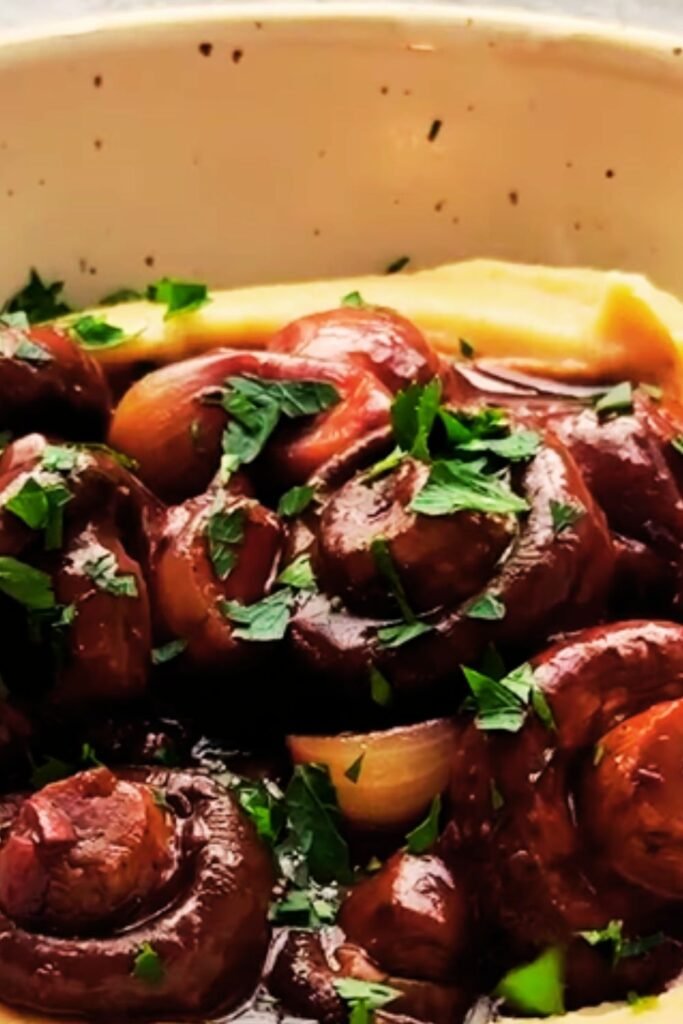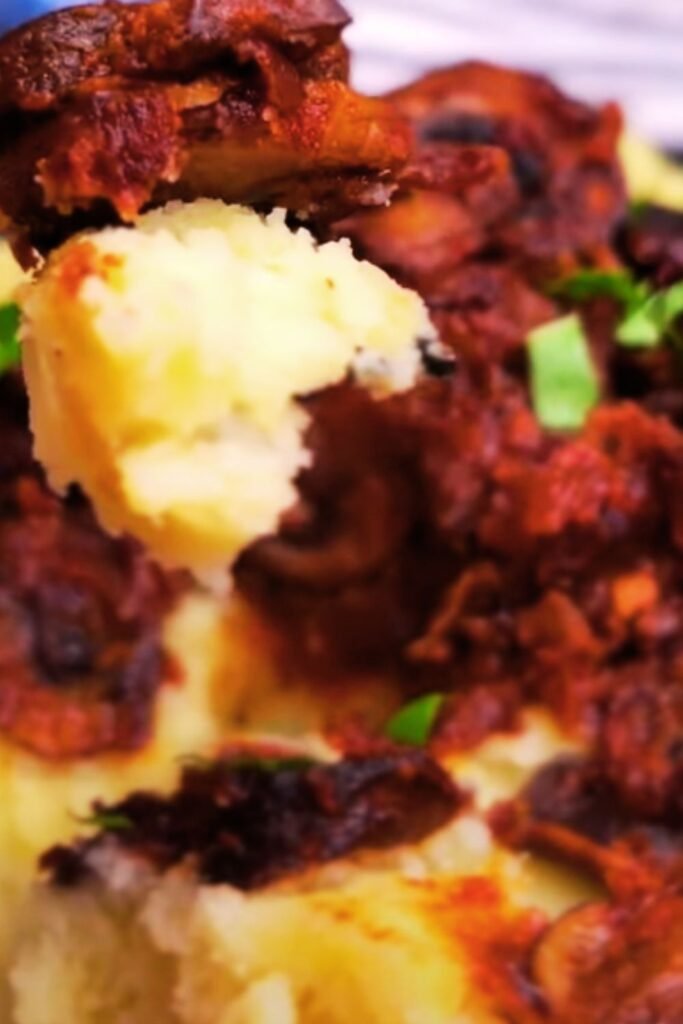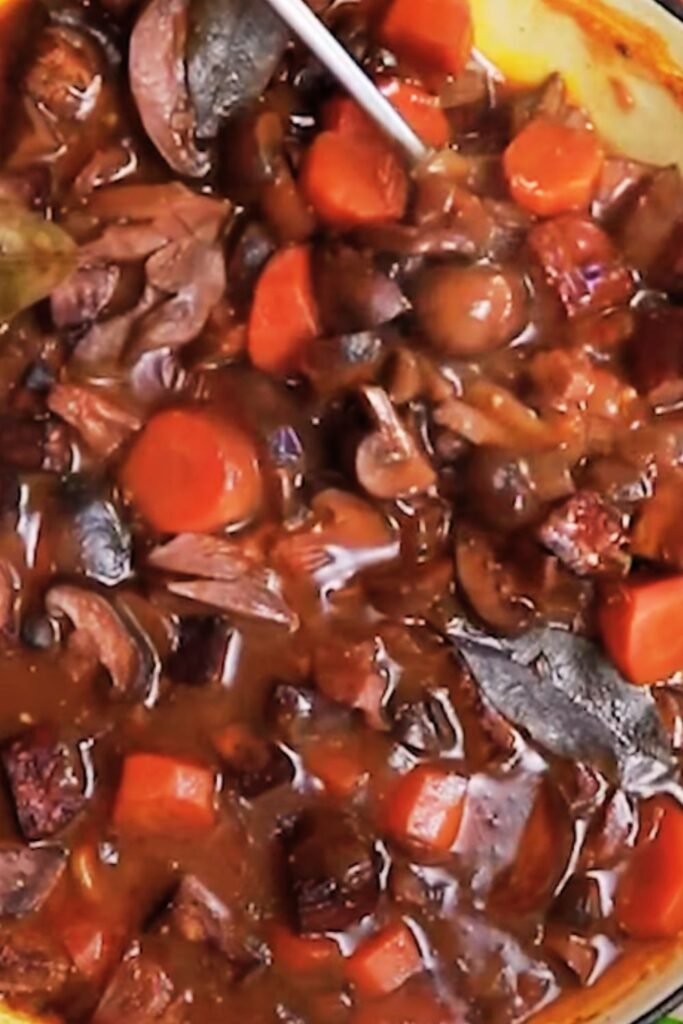When I first attempted to create a vegan version of the classic French Beef Bourguignon, I wasn’t sure it would capture the same rich, soul-warming essence that makes the original so beloved. After countless kitchen experiments and tweaks, I can confidently say that this Vegan Mushroom Bourguignon not only rivals its traditional counterpart but creates an entirely new experience that’s deeply satisfying and utterly delicious.
The beauty of this plant-based adaptation lies in how mushrooms naturally provide that meaty, umami-rich foundation that makes bourguignon so comforting. I’ve discovered that using a variety of mushrooms creates layers of flavor that develop beautifully during the slow cooking process, while red wine and aromatic vegetables build the complex flavor profile that defines this iconic dish.
What Makes This Vegan Bourguignon Special
My approach to veganizing bourguignon focuses on building depth through technique rather than simply substituting ingredients. I use a combination of searing, deglazing, and slow braising that mirrors traditional French cooking methods, ensuring every component contributes to the final symphony of flavors.
Key Elements of Success:
- Multiple mushroom varieties for complex texture and taste
- Proper browning techniques to develop rich flavors
- Strategic use of umami-boosting ingredients
- Traditional French cooking methods adapted for plant-based ingredients
- Perfect balance of herbs and aromatics
The result is a dish that’s both familiar and exciting, offering the same cozy satisfaction as the original while being completely plant-based and surprisingly accessible for home cooks.
Understanding the Ingredients
Mushroom Selection Guide
The mushroom combination is crucial to this recipe’s success. I’ve tested various combinations and found that using three different types creates the most satisfying result:
Primary Mushrooms:
- Portobello or King Oyster Mushrooms: Provide the “meaty” base with substantial texture
- Cremini (Baby Bella) Mushrooms: Add earthy depth and classic mushroom flavor
- Shiitake Mushrooms: Contribute intense umami and slightly chewy texture
Alternative Options:
- Porcini Mushrooms: Dried porcini can be rehydrated and added for intense flavor
- Maitake Mushrooms: Offer delicate texture and subtle taste
- Oyster Mushrooms: Provide tender texture and mild flavor
Wine Selection for Cooking
Choosing the right red wine significantly impacts the final dish. I prefer wines that are full-bodied but not overly tannic, as they need to complement rather than overpower the mushrooms.
Recommended Wine Types:
| Wine Variety | Flavor Profile | Why It Works |
|---|---|---|
| Pinot Noir | Light to medium body, bright acidity | Enhances mushroom earthiness without overwhelming |
| Côtes du Rhône | Medium body, balanced tannins | Traditional choice that pairs perfectly with herbs |
| Merlot | Smooth, fruit-forward | Adds richness without excessive tannins |
| Burgundy | Complex, earthy notes | Classic pairing that complements mushroom flavors |
Essential Aromatics and Herbs
The aromatic foundation distinguishes good bourguignon from great bourguignon. I use a classic mirepoix base enhanced with herbs that develop throughout the cooking process.
Aromatic Vegetables:
- Carrots: Cut into chunks for sweetness and color
- Celery: Provides subtle background flavor
- Pearl Onions: Traditional choice for authentic texture and mild onion flavor
- Shallots: Add sophisticated onion notes
- Garlic: Essential for depth and aroma
Herb Combination:
- Fresh Thyme: Earthy and slightly minty
- Bay Leaves: Provide subtle complexity
- Fresh Rosemary: Adds piney, aromatic notes
- Parsley: Fresh brightness for finishing
Complete Recipe
Ingredients
For the Mushroom Base:
- 2 pounds mixed mushrooms (portobello, cremini, shiitake), cut into 2-inch pieces
- 3 tablespoons olive oil
- 2 tablespoons vegan butter
- 1 teaspoon salt
- 1/2 teaspoon black pepper
For the Aromatics:
- 1 large onion, diced
- 3 medium carrots, cut into 1-inch pieces
- 3 celery stalks, chopped
- 1 cup pearl onions, peeled
- 6 cloves garlic, minced
- 2 shallots, diced
For the Braising Liquid:
- 1 bottle (750ml) dry red wine
- 2 cups vegetable broth
- 2 tablespoons tomato paste
- 2 tablespoons soy sauce or tamari
- 1 tablespoon balsamic vinegar
Herbs and Seasonings:
- 3 fresh thyme sprigs
- 2 bay leaves
- 1 rosemary sprig
- 1/4 cup fresh parsley, chopped
- 2 tablespoons flour (for thickening)
For Serving:
- 2 pounds small potatoes or egg noodles
- Fresh parsley for garnish

Step-by-Step Instructions
Preparation Phase (15 minutes):
- Prepare the mushrooms: Clean and cut all mushrooms into uniform 2-inch pieces. Pat them completely dry with paper towels – this step is crucial for proper browning.
- Prep aromatics: Dice onions and shallots, chop carrots and celery into 1-inch pieces, peel pearl onions, and mince garlic. Having everything ready makes the cooking process smooth.
- Organize seasonings: Tie thyme, bay leaves, and rosemary together with kitchen twine to create a bouquet garni for easy removal later.
Cooking Process:
Stage 1: Building the Foundation (20 minutes)
- Brown the mushrooms: Heat olive oil and vegan butter in a large, heavy-bottomed pot or Dutch oven over medium-high heat. Add mushrooms in batches, avoiding overcrowding. Let them cook undisturbed for 4-5 minutes until golden brown, then stir and brown the other sides. Remove and set aside.
Tip: Proper browning is essential – resist the urge to stir too frequently.
- Sauté aromatics: In the same pot, add diced onions and cook for 5 minutes until softened. Add carrots, celery, and pearl onions, cooking for another 5 minutes. Add garlic and shallots, cooking for 1 minute until fragrant.
Stage 2: Deglazing and Building Flavor (15 minutes)
- Add tomato paste: Stir in tomato paste and cook for 2 minutes, allowing it to darken slightly and become fragrant.
- Deglaze with wine: Pour in the red wine, scraping up any browned bits from the bottom of the pot. This fond adds incredible flavor to the final dish. Let the wine simmer for 5 minutes to cook off some alcohol.
- Add remaining liquids: Stir in vegetable broth, soy sauce, and balsamic vinegar. Add the herb bouquet and return mushrooms to the pot.
Stage 3: Slow Braising (1.5-2 hours)
- Bring to a simmer: Increase heat to bring the mixture to a simmer, then reduce heat to low. Partially cover the pot, leaving it slightly ajar for evaporation.
- Slow cook: Let the bourguignon simmer gently for 1.5 to 2 hours, stirring occasionally. The liquid should reduce by about half, and the mushrooms should be tender and infused with flavor.
Stage 4: Final Adjustments (10 minutes)
- Thicken if needed: If you prefer a thicker consistency, mix 2 tablespoons flour with 3 tablespoons cold water to create a slurry. Stir into the bourguignon and simmer for 5 minutes.
- Season and finish: Remove the herb bouquet, taste, and adjust seasoning with salt and pepper. Stir in fresh chopped parsley just before serving.

Nutritional Information and Benefits
This Vegan Mushroom Bourguignon isn’t just delicious—it’s also nutritionally impressive. Mushrooms are powerhouses of nutrients while being naturally low in calories and fat.
Nutritional Breakdown (Per Serving)
| Nutrient | Amount | % Daily Value |
|---|---|---|
| Calories | 285 | 14% |
| Protein | 12g | 24% |
| Carbohydrates | 18g | 6% |
| Dietary Fiber | 4g | 16% |
| Fat | 6g | 9% |
| Iron | 3.2mg | 18% |
| Potassium | 890mg | 19% |
| Vitamin D | 15IU | 4% |
| B Vitamins | Varies | 15-25% |
Health Benefits
Mushroom Power: Each variety of mushroom contributes unique nutrients. Shiitakes provide selenium and copper, while portobellos offer potassium and phosphorus. The combination creates a nutrient-dense base that supports immune function and provides sustainable energy.
Heart-Healthy Profile: This dish is naturally low in saturated fat and contains no cholesterol, making it heart-friendly. The fiber content helps regulate cholesterol levels, while potassium supports healthy blood pressure.
Antioxidant Rich: Red wine (even when cooked), herbs, and vegetables provide antioxidants that support overall health and may help reduce inflammation.
Serving Suggestions and Pairings
The beauty of bourguignon lies in its versatility as a main course. I’ve served this dish in various ways, each bringing out different aspects of its rich flavor profile.
Traditional Accompaniments
Starchy Bases:
- Creamy mashed potatoes: The classic pairing that soaks up the rich sauce beautifully
- Egg noodles or pasta: Wide noodles work best for capturing the sauce
- Crusty French bread: Perfect for sopping up every drop of the flavorful broth
- Polenta: Creamy cornmeal provides a comforting, neutral base
Fresh Elements:
- Simple green salad: Dressed with vinaigrette to cut through the richness
- Steamed green beans: Light and crisp to balance the hearty main dish
- Roasted Brussels sprouts: Adds a slight bitter note that complements the wine flavors
Modern Presentation Ideas
I love serving this bourguignon in individual cast-iron skillets for a rustic, bistro-style presentation. Garnishing with fresh herbs and a dollop of vegan crème fraîche elevates the dish for special occasions.
Creative Serving Options:
- Over cauliflower mash for a low-carb alternative
- Stuffed into puff pastry shells for elegant individual portions
- As a topping for baked sweet potatoes
- Mixed with wild rice for a complete one-bowl meal
Storage and Reheating Guide
One of the best aspects of bourguignon is how it improves with time. The flavors continue to meld and deepen, making leftovers often better than the original meal.
Storage Instructions
| Storage Method | Duration | Best Practices |
|---|---|---|
| Refrigerator | 4-5 days | Store in airtight container, cool completely first |
| Freezer | 3 months | Freeze in portion-sized containers, label with date |
| Meal Prep | 3 days | Prepare components separately for best texture |
Reheating Tips:
- Stovetop: Gentle reheating over low heat maintains texture
- Oven: Cover and reheat at 325°F for even warming
- Microwave: Use 50% power to prevent overcooking mushrooms
The mushrooms may release additional liquid when stored, which is normal. Simply simmer uncovered for a few minutes to reduce excess liquid if needed.
Troubleshooting Common Issues
Through my experience making this recipe countless times, I’ve encountered and solved several common challenges that home cooks face.
Texture Problems
Issue: Mushrooms become soggy
- Solution: Ensure mushrooms are completely dry before browning, don’t overcrowd the pan, and maintain proper heat for good caramelization.
Issue: Sauce is too thin
- Solution: Remove the lid during the last 30 minutes of cooking to encourage evaporation, or create a flour slurry to thicken.
Issue: Vegetables fall apart
- Solution: Cut vegetables into larger pieces and add delicate ones later in the cooking process.
Flavor Challenges
Issue: Lacks depth of flavor
- Solution: Ensure proper browning of mushrooms and aromatics, use a combination of mushroom varieties, and don’t skip the deglazing step.
Issue: Too acidic from wine
- Solution: Let the wine reduce properly during deglazing, and balance with a touch of maple syrup or balsamic vinegar.
Issue: Missing richness
- Solution: Add a tablespoon of nutritional yeast or miso paste for umami depth, or finish with a pat of vegan butter.

Variations and Adaptations
My basic recipe serves as a foundation for numerous delicious variations. I encourage experimenting with different ingredients based on seasonal availability and personal preferences.
Seasonal Variations
Spring Version: Add fresh peas, asparagus tips, and baby carrots in the last 20 minutes of cooking. Use lighter herbs like tarragon and chives.
Summer Adaptation: Incorporate zucchini, yellow squash, and cherry tomatoes. Finish with fresh basil and serve at room temperature as a rustic ratatouille-style dish.
Fall Enhancement: Add roasted butternut squash, parsnips, and use heartier mushrooms like maitake or hen-of-the-woods. Include warming spices like a pinch of cinnamon.
Winter Comfort: Incorporate root vegetables like turnips and rutabaga, add dried mushrooms for intensity, and serve over creamy polenta.
Dietary Adaptations
Gluten-Free: Use tamari instead of soy sauce and cornstarch instead of flour for thickening.
Oil-Free: Sauté vegetables in vegetable broth or use an air fryer for browning mushrooms.
Lower Sodium: Reduce or eliminate added salt, use low-sodium vegetable broth, and increase herbs and spices for flavor.
Q&A Section
Q: Can I make this recipe without wine? I understand that not everyone wants to cook with alcohol. You can substitute the wine with additional vegetable broth plus 2 tablespoons of balsamic vinegar and 1 tablespoon of grape juice for complexity. The flavor will be different but still delicious.
Q: How do I know when the mushrooms are properly browned? Properly browned mushrooms should have a golden-brown color and shouldn’t release moisture when cooking. If you see liquid pooling in the pan, increase the heat and avoid stirring until they develop color. This usually takes 4-5 minutes per side.
Q: Can I use frozen mushrooms for this recipe? Fresh mushrooms work best because frozen ones release too much water and don’t brown properly. If you must use frozen, thaw them completely, pat very dry, and expect a different texture in the final dish.
Q: Why does my bourguignon taste bland compared to restaurant versions? Restaurant versions often use more salt, butter, and sometimes meat-based stocks for depth. Try adding nutritional yeast, miso paste, or a splash of soy sauce for umami. Also, ensure you’re browning the mushrooms properly and reducing the wine adequately.
Q: How can I make this recipe more protein-rich? Add white beans, lentils, or chunks of seasoned tofu or tempeh. I sometimes include cannellini beans in the last 30 minutes of cooking for extra protein and creaminess.
Q: Can I prepare this in a slow cooker? Yes, but brown the mushrooms and sauté the aromatics on the stovetop first, then transfer everything to your slow cooker. Cook on low for 6-8 hours or high for 3-4 hours. The texture will be slightly different but still delicious.
Q: What’s the best way to peel pearl onions easily? Blanch them in boiling water for 2 minutes, then immediately transfer to ice water. The skins should slip off easily. You can also buy pre-peeled frozen pearl onions to save time.
Q: My vegetables are cooking at different rates. What should I do? Add vegetables in stages based on their cooking times. Start with harder vegetables like carrots, add mushrooms and onions next, and finish with quicker-cooking items like garlic in the last few minutes of sautéing.
Q: Can I double this recipe for a crowd? Absolutely! Just make sure you have a large enough pot and brown the mushrooms in batches to avoid overcrowding. The cooking time may need to be extended slightly, but the technique remains the same.
Q: How do I prevent the bottom from burning during long cooking? Use a heavy-bottomed pot, maintain low heat, and stir occasionally. If you notice sticking, add a splash of broth and scrape up any browned bits. A heat diffuser can help distribute heat evenly.
This Vegan Mushroom Bourguignon represents everything I love about plant-based cooking—taking classic techniques and traditional flavors while creating something entirely new and satisfying. The slow development of flavors through proper browning and braising creates a dish that’s both familiar and exciting, proving that vegan cooking can be just as rich and complex as any traditional recipe.
Whether you’re cooking for committed vegans, curious omnivores, or anyone who simply loves good food, this bourguignon delivers comfort and sophistication in equal measure. The beauty lies not just in its taste, but in how it brings people together around the table, sharing in the universal pleasure of a well-cooked, heartwarming meal.